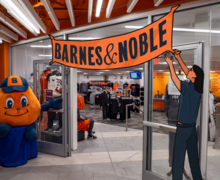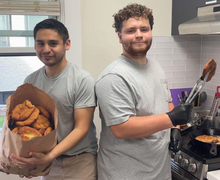Invent@SU awards $3K to student inventions
Leonardo Eriman | Staff Photographer
Alexander Deyhim, the Kenneth and Mary Ann Shaw Professor of Practice in Entrepreneurial Leadership, has directed Invent@SU for the past two years. He said called the event a valuable experience for everyone involved.
Get the latest Syracuse news delivered right to your inbox.
Subscribe to our newsletter here.
Nathan Brekke, a Syracuse University junior studying computer science, first came up with his $1,500-prize-winning invention while on a hike.
Upon coming across a body of water, the early concepts of the “Phloat” — a compact phone case that deploys a flotation device in its case in an emergency — popped into Brekke’s mind, he said. He had no way of knowing this idea would later lead his team to a first-place prize in SU’s 2024 Invent@SU competition, an invention intensive hosted by SU’s College of Engineering and Computer Science.
“Since we won first place, (it) kind of validated our idea as something that was alright, like people are interested in it,” Brekke said. “I’m really excited about it.”
The winners of Invent@SU included a variety of inventions — from everyday items and medical tools to data monitoring services. The teams that placed received prizes ranging from $600 to $1,500.
Invent@SU is a six-week-long intensive program intersecting STEM and entrepreneurship ideals, according to its website. Students applied for the program in March and began in May. Applicants were then placed into teams and tasked with creating something that solves an ongoing issue in people’s lives. Eight teams participated in this year’s competition.
Brekke’s Phloat invention won first place. The phone case brings a submerged phone up to the surface of the water and keeps it floating for up to 30 minutes, Brekke said. He pinned the experience among the best things he’s done at SU.
The first-place team included Brekke, Elijah Alexander, a sophomore majoring in civil engineering, Malak Aljerari, a sophomore majoring in biomedical engineering, and Joshua Varkey, a junior majoring in aerospace engineering.
While on the hike that inspired “Phloat,” Brekke said he recalled a product he previously saw that deploys life vests using a carbon dioxide canister. He thought similar technology could be applied to cell phone cases.
“Smartphones nowadays are waterproof or water-resistant, at least on their own for up to 30 minutes (at) 20 feet,” Brekke said. “The problem is, if you drop the phone into deep water, you’re still not gonna get it.”
After winning first place, the team recently won in the BlackStone Launchpad pitch competition, securing $10,000 to further their invention. They hope to file for a patent and bring the invention to market, Brekke said.
Two inventions, “MagniClaw” and “Swift Straps,” tied for second place.
MagniClaw, a wheelchair stabilization system, can be mounted at any surface to allow wheelchair users to situate in vehicles by themselves, unlike current systems that require another person’s assistance. The invention uses a mechanical clamp and strong magnets, allowing for quadriplegic and paraplegic users to be fully secured while in transportation.
Carter Thompson, a junior majoring in aerospace engineering, was a part of the team that created MagniClaw. He said the inspiration for the invention came after meeting with an SU alumnus who shared his struggles with transportation as a quadriplegic.
“We eventually did a bunch of research … and found that he’s not the only person who deals with this issue,” Thompson said. “Almost all the options on the market are either identical to the one he currently has … or don’t allow for user independence.”
After placing second at the competition, Thompson and his teammates — Davis Hood, a junior majoring in electrical engineering, Jennifer Mason, a junior majoring in mechanical engineering, and Matthew Pinto, a sophomore majoring in biomedical engineering — are now working to file their invention for a provisional patent.
Swift Straps, the other second-place finisher, serves as an alternative option for EMTs to lock patients onto a spine board without the stress of dealing with straps. The straps are retractable, allowing more flexibility for EMTs to secure their patients.

Lucía Santoro-Vélez | Presentation Director
Amira Salihovic, a senior majoring in biomedical engineering, said the idea for Swift Straps came from her teammate Jessica Moreno’s experience as an EMT. Moreno said it was difficult to quickly secure patients when needed.
EMTs are not currently equipped with retractable straps, oftentimes leaving them dangling on the ground or getting caught on the wheels of the stretcher, Salihovic said.
“When she worked as an EMT, the straps were kind of just jangling all over the place,” Salihovic said.
The “R!G” team won third place for their solution to lumbar spine pain. The invention uses a mix of materials to support muscle exhaustion in the lower back area.
Ava Lubkemann, a sophomore majoring in environmental engineering, said the biggest challenge of creating R!G was making sure all measurements for the device were accurate, which she said was challenging to accomplish within the competition timeline.
Along with Lubkemann, the rest of the team included Robert Adinolfi, a freshman studying mechanical engineering, Brayden Phillips, a sophomore studying chemical engineering and Jair Espinoza, a senior studying computer science.
Alexander Deyhim, director of Invent@SU, has been in charge of the program for the last two years. He called the annual event a valuable experience for everyone involved.
“We have an amazing group of alumni in industry,” Deyhim said. “They give (our students) feedback so they can refine their design. It’s a win-win. Our alumni are excited to give back to SU. Our students are excited to get real-world feedback — it can’t go wrong.”
Deyhim said students often go into the program expecting to learn technical skills. Instead, students are taught leadership, communication, collaboration and marketing skills — along with industry skills like designing and prototyping.
The program’s leadership hopes to grow in the future, starting by expanding the number of involved students, Deyhim said. Currently, each cohort consists of 30 students.
“If we can grow this program it would be amazing, because this is a priceless opportunity for our students,” Deyhim said.
DISCLAIMER: Davis Hood, a member of the MagniClaw team, is the IT manager of The Daily Orange. He does not influence the editorial content of the News section in his capacity as IT manager.
Published on October 3, 2024 at 1:51 am
Contact Zaara: zamalik@syr.edu






